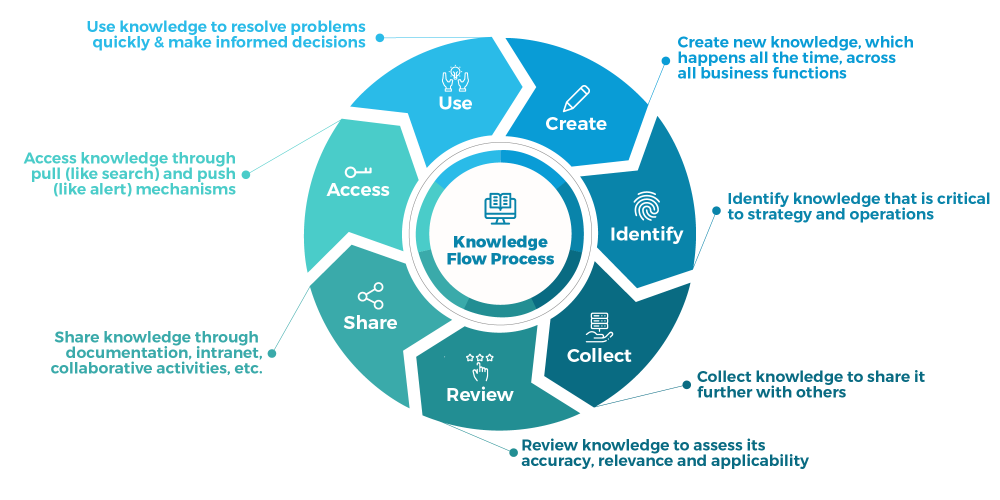
Despite knowledge management being an indispensable part of business survival and growth, managers fail to implement it successfully across the entire organization. For starters, they mistake a general plan to make knowledge accessible to employees for a strategy. Secondly, they are incapable of tracing and articulating knowledge. Also, if the knowledge is recognized and recorded, turning tacit knowledge into explicit remains a challenge. By and large, a successful KM program increases productivity and goodwill of your brand whereas a failed one holds your business back by millions of dollars. In this blog post, we’ll help you chalk out a successful knowledge management strategy so that you can scale your KM efforts. Let’s get rolling.
Key Components of Knowledge Management Strategy
In order to frame a successful KM strategy, managers cannot simply turn a blind eye to the following components:
1. People
They are the ones who keep, share, and apply knowledge. Therefore, your KM program should encourage people within the organization to share and influence others with their knowledge.
2. Processes
Ideal processes include best practices and governance for the efficient capture, storage, dissemination and reuse of knowledge. A standard knowledge flow process is the following seven‑stage cycle:

3. Technology
An investment in technology is non‑negotiable to sustain the cutthroat competition. Make your KM program a big hit by choosing a technology that is user‑friendly and enhances knowledge management automation.
4. Structure
A successful KM program includes an organizational structure that encourages cross‑functional awareness and expertise for effective implementation of the program.
5. Culture
All your efforts are down the drain if your organization doesn’t promote a knowledge‑sharing culture. Therefore, for a KM strategy to be successful, establish a knowledge‑driven culture within your organization.
7 Ways to Future‑Proof Your KM Strategy
Knowledge management can make or break your brand image, which in turn affects the overall growth of your business. Here we present you seven tried‑and‑trusted ways to future‑proof your knowledge management program so that you can stay productive and profitable in the long run.
1. Remember Your Users While Mapping Out KM Journey
One of the biggest blunders while framing a KM strategy is forgetting about users’ behavior and their competencies. You can choose the best technology, but if employees are neither competent nor trained to utilize it; then at best, they will try to circumvent the process, and at worst, they will not use the KM solution at all. One of the most effective ways to create KM success stories within business units is to involve your user community upfront in your KM journey. Read our blog post on community engagement to unravel the mystery of creating a hyper‑engaged online community.
2. Integrate Your KM Program with a State‑of‑the‑art Technology
In the digital era where we are heavily reliant on technology for automation, it’s high time to evaluate what kind of technology will enhance and automate your KM efforts. Ascertain and prioritize your KM technology needs based on the objectives of your KM program. Irrespective of objectives, a technology laid on the foundation of robust cloud infrastructure, enterprise search, and support fits all programs. After all, automation of KM tasks such as content management, meta‑tagging, expertise location, etc. empower the KM team by providing a certain degree of precision, consistency, and efficiency to your KM efforts. Since the market is flooded with KM solutions, it is imperative to know primary providers and weigh them on the basis of cost and benefits offered before adopting one.
3. Measure Your KM Program’s Success with Back‑end Analytics
As the saying goes, “If you can’t measure it, you can’t manage it”. While selecting the best fit for your KM program, don’t overlook the need for back‑end analytics. By tracking users’ behavioral patterns, trends, content gaps, engagement rates, etc., analytics gauge the relevancy of content and help you deliver the right content at the right time. It also helps your customers and employees to successfully self‑serve. Last but not least, analytics helps you make data‑driven and informed decisions.
4. Proactively Organize and Manage Your Content
Since content needs are constantly changing, it is of paramount importance to have scalable content sources. Organize your content with a vision because as your knowledge base grows, it becomes complex. Frame a content management strategy to give order to chaos. Leverage AI‑powered tools to label your content correctly in order to keep a check on duplicacy and redundancy of content. Last but not least, do not forget to add articles in your knowledge base whenever new issues emerge, new features are launched or important processes undergo a change. This way you empower your users to self‑serve themselves as whenever any query related to a new feature or new issue is raised, the new content is immediately pulled out and made available for use.
5. Create a Unified Knowledge Management Flow
Since information is stored in disparate silos, most employees aren’t aware of the existing knowledge and expertise. They end up sifting through databases, servers, emails, etc. to find and access the right information at the right time. Doesn’t sound too effective, does it? Well, here’s where the need for a unified KM flow arises. AI‑powered search unifies your enterprise knowledge under a singular index without compromising on the original location of the information. With a unified, 360‑degree view of the knowledge base, employees can easily locate the right information and expertise whenever needed, no matter if they’re across the office or across the globe.
6. Make Your KM Program Adaptive to Change
The KM program doesn’t work well with a fire‑and‑forget approach. To keep pace with the changing environments, it demands process revisions, agile thinking, design thinking, and strong employee adoption ‑ all of which further demand regular maintenance. With ML‑powered cognitive technology, you can certainly gather data that helps you stay ahead of the curve.
7. Leverage the Brain Power within Your Organization with KCS
You can utilize numerous ways to leverage the work and brainpower within your organization. Knowledge‑Centered Services (KCS) is one such methodology that integrates the creation and maintenance of knowledge at every digital touchpoint. It also fosters cross‑functional knowledge sharing and collaborations.
Looking for Solutions to Effectively Tackle the Information Chaos at Your Workplace?
The ultimate goal of knowledge management is to free your employees from the occasional information runs that impediment their productivity and efficiency. Cognitive technology connects the dot between people, processes, and technology to make the right information available at the right time to the right people. Download our e‑book to learn how you can overcome knowledge sharing and management hurdles with cognitive solutions.

















